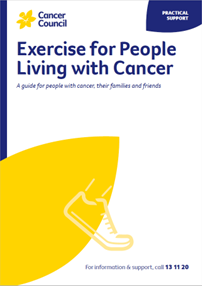- Home
- About Cancer
- Living well
- Exercise for people living with cancer (with videos)
- Getting started
- Planning an exercise session
Planning an exercise session
Below we look at how to plan an exercise session and ways to stay motivated.
Learn more about:
The 3 parts of an exercise session
There are 3 general parts to an exercise session.
1. Warm-up
The aim of a warm-up is to increase blood flow to warm your muscles or gradually raise your heart and breathing rates. This prepares your body for further activity without a sudden elevation.
A warm-up can include 5–10 minutes of low intensity aerobic and cardio exercise and light stretching. Walking or stepping up and down on a stair are good warm-ups. If approved by your doctor or exercise professional, you can use light weights to warm up before strength training.
2. Training
This is the part of an exercise session when the work is done. It could include activities from one or more types of exercises:
- aerobic and cardio exercises
- strength and resistance training
- flexibility exercises
- balance exercises. People with weakened bones or peripheral neuropathy can improve stability with balance exercises
- pelvic floor exercises. Some people may need to exercise their pelvic floor muscles – especially if they have leaking or incontinence issues.
3. Cool-down
The cool-down allows your heart rate and blood pressure to gently return to normal. It also helps your body and muscles recover and reduces soreness after exercise. After aerobic or cardio exercise, cool down with 5–10 minutes of relaxed, low intensity activity such as slow walking or cycling. After strength or resistance training, you can cool down with light stretching.
Ways to stay motivated
Start an exercise diaryRecord each day’s physical activity and exercise in a paper or digital diary or calendar. List the type of activity, and how long and hard you exercised. | |
Go onlineUse free websites such as MyFitnessPal.com to record your exercise sessions. You can also use this website to record how much you’re eating and exercising. | |
Use fitness appsFree smartphone apps such as Runkeeper, MyFitnessPal or STRAVA track your movement while you are exercising if you wear a smartwatch or keep your smartphone on you, or you can record your activity later. You can download them from the App Store (Apple) or Google Play (Android). | |
Wear a gadgetAlso called wearables, devices such as those from Fitbit and Garmin are worn like a watch. They can track your steps or minutes of activity and transfer the data to your smartphone or computer. Some also monitor your heart rate and take electrocardiogram (ECG) measures. | |
Have options for bad weatherA combination of indoor and outdoor exercise options will mean you can keep exercising even if the weather changes or if it’s after dark. | |
Buddy up with someoneExercise with family and friends to keep each other motivated. You can even share an online class together. |
→ READ MORE: The different muscle groups
More resources
Kirsten Adlard, Accredited Exercise Physiologist, The University of Queensland, QLD; Dr Diana Adams, Medical Oncologist, Macarthur Cancer Therapy Centre, NSW; Grace Butson, Senior Physiotherapist, Peter MacCallum Cancer Centre, VIC; Kate Cox, 13 11 20 Consultant, Cancer Council SA; Wai Yin Chung, Consumer; Thomas Harris, Men’s Health Physiotherapist, QLD; Clare Hughes, Chair of Cancer Council’s Nutrition, Alcohol and Physical Activity Committee; Jen McKenzie, Level 1 Lymphoedema Physiotherapist, ESSA Accredited Exercise Physiologist, The McKenzie Clinic, QLD; Claudia Marck, Consumer; Dr David Mizrahi, Accredited Exercise Physiologist and Research Fellow, The Daffodil Centre at Cancer Council NSW and The University of Sydney, NSW; Prof Rob Newton, Professor of Exercise Medicine, Exercise Medicine Research Institute, Edith Cowan University, WA; Jason Sonneman, Consumer.
View the Cancer Council NSW editorial policy.
View all publications or call 13 11 20 for free printed copies.

